Finally, here is my complete transcription.
Asturias_Full_Score.pdf
Category Archives: Classical
Rethinking Albeniz’s Asturias part 4
Now let’s look at the lyrical middle section. In contrast to the opening section, this section evokes cante jondo through the use of the phrygian mode (D phrygian), ornamentation and the use of augmented 2nd intervals. The melody is doubled at the 15th, and each section of melody is briefly answered with chords in the same manner as a guitarist will answer each section of singing in many forms of cante de Levante.
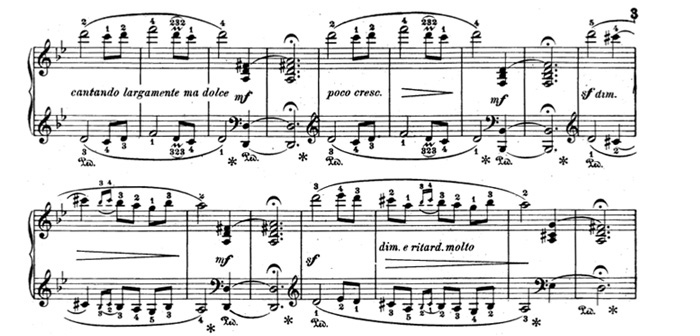
It really surprises me that all four of the transcriptions I’ve been looking at (Fortea, Prat, Segovia and Yates) double the melody at the octave rather than the 15th – double octaves are quite manageable on the guitar by playing at the same fret on both E strings. The only guitar versions I’ve heard with the 15th intact are Yepes (some live versions) and David Russell (briefly, right at the end of the middle section).
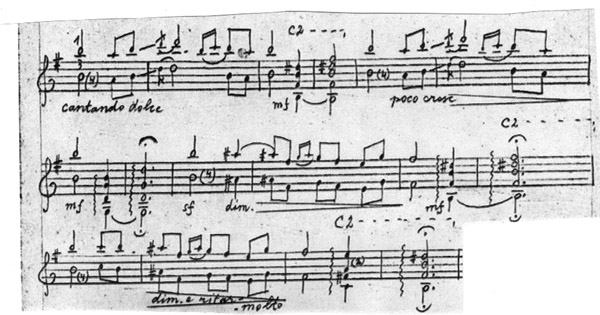
Segovia changes the augmented 2nds in bars 72 and 76 to major 2nds. This is more in line with the Western European tradition, but overly softens the exotic sound of the melody. Yates has pointed out that in the earliest editions of the piece, the augmented 2nd ornaments in bars 72 and 76 were written out in full, leaving little doubt of Albeniz’s intentions. Later editions had the ornament changed to a major 2nd – we can speculate that this may have sounded more correct to an editor accustomed to classical music conventions.
Yates not only restores the augmented 2nd missing from Segovia’s transcription, but further accentuates them with cross-string ornaments. This is a departure from the rest of Yates’ transcription, in that he is using a guitaristic effect, not following the piano original but following the mood he presumably believed Albeniz intended.
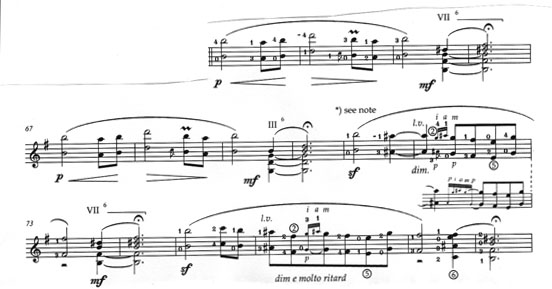
Rethinking Albeniz’s Asturias – part 3
Following on from parts 1 and 2, let’s look at the end of the opening section, in the piano original an arpeggiated flourish spanning five octaves in the dominant key of D major:

This poses a problem for guitar transcriptions as the guitar has a range of roughly three and a half octaves. In the key most guitar transcriptions are in, Em, this becomes a B major arpeggio, only giving a range of three octaves. Forte dramatically changed this section – the arpeggio is shortened with the semi quavers of the original being replaced by triplets spanning just one bar, giving a 3 octave arpeggio. This effectively solves the problem of range, but gives a much more subdued effect than the original’s spectacular five octaves of semiquavers. He finishes with a 19th fret harmonic for the final high B, using some artistic license in using a technique not available to the piano.

Prat’s arpeggio has one bar of semiquavers in the same pattern as the original, followed by one of quavers – slowing down the rhythm by half and avoiding running out of range. Like Fortea he ends with a 19th fret harmonic for the final high B.
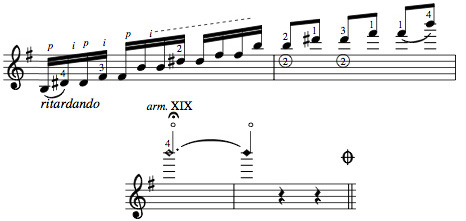
Segovia uses a three octave arpeggio of quavers, with a pizzicato effect added. The technique of pizzicato has no equivalent technique on the piano, so he is clearly adding something to the score not alluded to in the original. Like Fortea, the overall effect is quite subdued compared to the original.

Yates has an arpeggio very close to the original, with the same repeated semi quavers over two bars. He drops an octave in the second beat of bar 60, to avoid exceeding the guitar’s range, and adds a 19th fret harmonic at the end, in common with the other three transcriptions I’ve looked at.
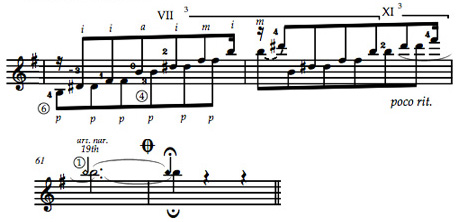
Four quite different solutions – in my opinion Yates’ is the only one that does the section justice.
Rethinking Albeniz’s Asturias – part 2
For part 2 of this series, let’s have a look at bars 37–39. This is part of the climax of the opening allegro section, where similar melodic material to the opening is punctuated by accented chords, imitating the rasgueado (strumming with the backs of the right hand nails) technique on the guitar. Here we see a favourite harmonic device of Albeniz’s, the augmented-sixth Phrygian dominant used in place of an ordinary dominant. In this case a C# augmented-sixth which leads into a D major chord. This passage is especially problematic for guitar transcriptions, as we shall see, as the exact voicing of the original is impossible on the guitar.

Fortea keeps the augmented 6th chord of the original, revoiced for the guitar, with the bass A# undoubled and raised one octave higher. His chord seems a good solution in many respects, however it does weaken the voice leading of the bass A# leading to bar 40’s B major chord, as the octave has shifted. There is also the issue of making the chord fortississimo when it is played on only the four treble most strings.
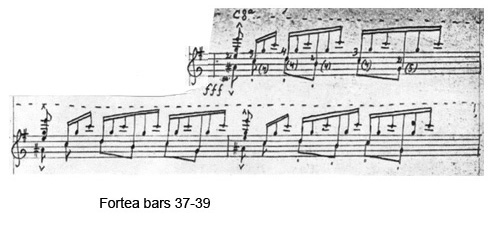
Prat takes a different approach – the C# augmented 6th chord (which would be an A# augmented 6th chord in the guitar key of Em), is replaced with a C dominant 7th chord. Although both chords share the same notes (with the A# spelt Bb in the case of C dominant 7th) the sound is somewhat different. The original chord transposed to the key of this transcription would have the bass A# leading into the B of the B major chord about to arrive in bar 41. The C dominant chord does allow for a strong six string voicing, and gives a strong cadence when it resolves to B major in bar 41. Segovia uses the same chord in his published score, however in his recorded version he uses a chord more similar to the original with an A# in the bass.
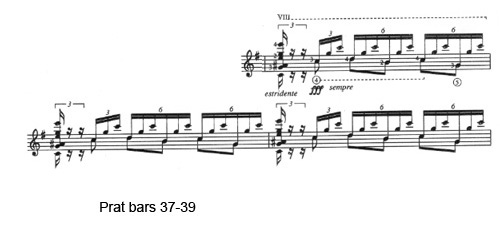
Keeping the A# in the bass and the high E in the treble makes for some very difficult fingerings. Yates retains the A# in the bass keeping the harmony intact, but changes the treble to a C. Yates has explained why he would rather keep the A# in the bass and sacrifice the high E: “it is this note [the A#] that defines the inversional quality of the harmony, and which provides very strong chromatic voice-leading in the lower voice” (from this article).

In the following figure I have transposed the original chord to the key of Em, and compared it to solutions found in the transcriptions of Fortea, Prat, Segovia, The chord found in Segovia’s recorded version, and Yates. Numbers 6 and 7 are both my attempts by to find a different solution retaining both outer voices of the original. Of the transcriptions I’ve looked at, only Fortea and Segovia (in the recorded version) have kept the outermost notes unchanged, albeit with different octaves, thus changing the voice leading. Prat and Segovia (published version) Have a revoiced version, somewhat changing the sound to that of a C dominant 7th chord. Yates changes highest note, keeping the bass intact. my two attempts are unfortunately very difficult to finger for the left hand, and still have the disadvantage of containing only four strings, making it difficult to make them sound fortissimo.

For my final transcription I decided to use the following chord:
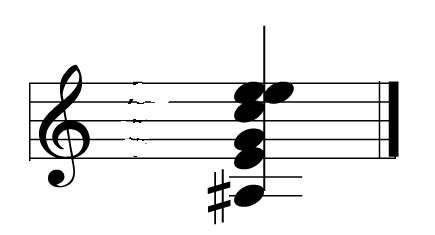
This is a common problem when transcribing from guitar. As always there is no right answer, just a compromise that hopefully works in the context of the rest of the transcription.
Rethinking Albeniz’s Asturias – part 1
Last year I worked on my own transcription of Albeniz’s Asturias as a research project for my studies. The first obvious place to look was the piano original, then I looked at transcriptions from Fortea (sometime before 1920), Prat (1920), Segovia (Published 1956 but he was playing some version of Asturias as early as 1924) and Yates (1999). Listening to the original it was obvious that a note for note rendering of the original wouldn’t be possible on the guitar for a number of reasons, among them an unsuitable key, impossible chord voicings and a wider range than the guitar allows. For this reason many choices must be made by the transcriber and/or performer to make the piece work. It was fascinating looking at the approaches these four transcribers took in solving common problems, as well as what liberties they took beyond simply trying to remain faithful to original. By the way I’m referring to the piece as “Asturias” because that’s the name it’s most often known by – even though this title was probably given to the piece well after Albeniz’s death, and the piece clearly references Andalucia rather than Asurias in Spain’s North. (Stanley Yates gives a great explaination of the back story of this here).
Let’s look at the opening allegro section. The twelve beat melodic cycle and accent every 6 or 12 quaver beats is reminiscent of a buleria. The constant peddle-point sitting in the middle of the range of the melody imitates the popular guitar device where an open treble string is used to play a peddle point with the right hand index or middle finger, while the thumb plays the melody using the bass strings.
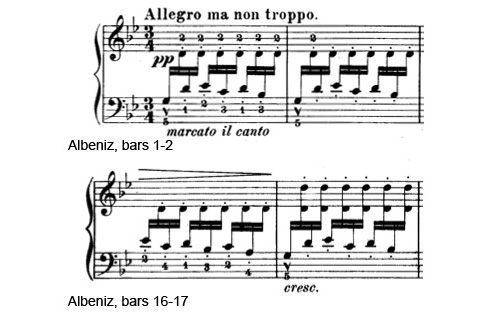
This is clearly a piano pretending to be a guitar – so what happens when we have a guitar pretending to be a piano pretending to be a guitar? let’s look at the same bars in the earliest transcription I know of, that of Daniel Fortea (a copy of which is available from Matanya Orphee’s website here):
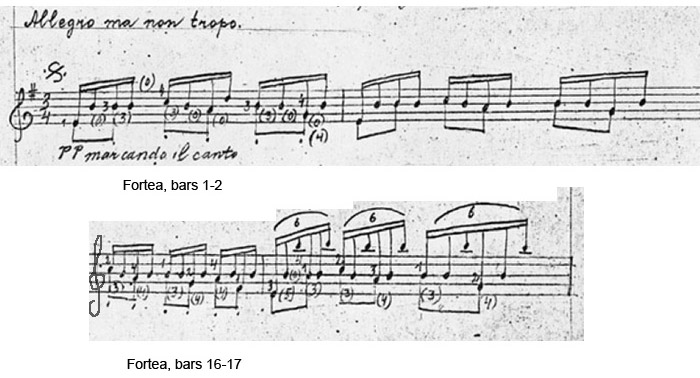
Fortea keeps the staccato marks of the original, as well as the dynamics and other indications, intact. The Interesting thing is that he adds a triplet figure not in the original. This figure continues on for most of the first section, and has been copied in most subsequent transcriptions; Prat and Segovia do pretty much the same thing, minus the staccato marks. Of the four transcriptions I looked at, only Yates looked back to the piano original:
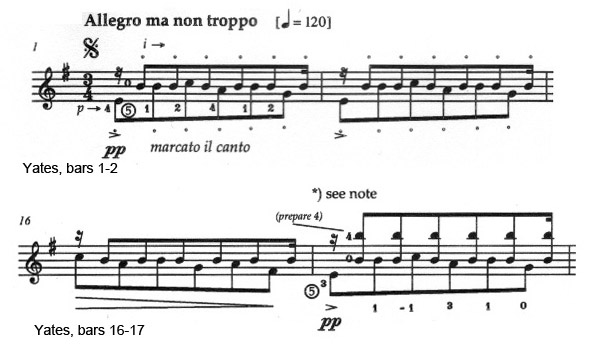
The triplet figure has been attributed to Segovia before, however it does seem that the idea was already in common use before Segovia made his transcription – Segovia mentions in his memoirs that Fortea’s transcription had been the one he’d seen played up to the point he started working on his own transcription.
So why add a triplet figure? While we can probably never know the reason for the addition of the triplets, they make sense in light of certain compromises which must be taken as the piece is carried over from the piano score. In the original the dynamics move gradually from pp to fff over the first 32 bars. The guitar has less dynamic range so cannot reproduce this crescendo to the extent Albeniz would have intended. Also the crescendo is heightened in bars 25-32 with the accented chords appearing every 3 or 6 beats, which become more and more widely spaced, culminating in bar 33 with a G minor chord stretched over 5 octaves. This is not possible with the guitar’s range. To make up for this, the triplet figure adds weight to the sound giving more of a sense of crescendo.
The other interesting thing is the stacatto marks, which are kept in Fortea and Yates but eliminated in Prat and Segovia. The staccato markings I believe are part of the attempt to make the piano sound like a guitar, more specifically a flamenco guitar. The flamenco guitar is built traditionally to have a strong attack but not much sustain. The classical guitar has more sustain but still much less than the modern piano. For this reason I feel keeping the staccato marks on the guitar version may be misguided – if it is a device to make the piano sound like a guitar, there is no need if one is actually playing the guitar.
Variations on an Anatolean folksong
This is one of my favorite pieces right now. Domeniconi lived in Turkey for quite some time, and the folk music of Turkey is a strong influence in a lot of his work.
Odeon
This is Raphael Rabello’s version of Odeon, by Ernesto Nazareth (originally for piano). I’ve always loved Raphael’s version, the way he weaves in some Granainas at the beginning and towards the end, showing the influence his friend Paco de Lucia had on him at the time.
The video is from a recital I did at Elder Hall, Adelaide last year (2012) as part of an exam. This version is based on a couple of different Raphael Rabello performances, one from the album ‘Cry my Guitar’ and the other from a YouTube clip of a Brazilian TV show.
Odeon.gpx (requires guitar pro to read)
Odeon.pdf
